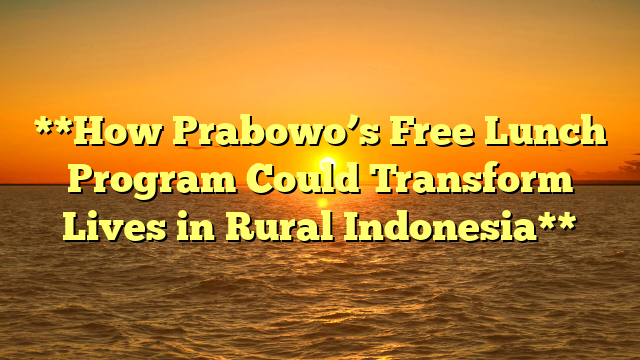
Indonesia, a nation of over 270 million people, is a land of contrasts. While samosir88 like Jakarta and Surabaya thrive with economic activity, rural areas often lag behind, grappling with poverty, malnutrition, and limited access to education. In this context, Prabowo Subianto’s proposed free lunch program has sparked both hope and debate. If implemented effectively, this initiative could be a transformative force for rural Indonesia, addressing critical issues such as child malnutrition, education, and economic development.
One of the most pressing challenges in rural Indonesia is malnutrition. According to UNICEF, nearly one in three children under five in Indonesia suffers from stunting, a condition caused by chronic malnutrition that impairs physical and cognitive development. This issue is particularly acute in rural areas, where access to nutritious food is often limited. Prabowo’s free lunch program aims to provide meals to schoolchildren, ensuring they receive at least one nutritious meal per day. By tackling malnutrition at its root, the program could significantly improve the health and well-being of millions of children, enabling them to grow into healthier, more productive adults.
Beyond addressing malnutrition, the free lunch program has the potential to boost school attendance and performance. In many rural communities, children often skip school to help their families with farming or other labor-intensive tasks. For some, the lack of a reliable meal at school is a disincentive to attend. By offering free lunches, the program could encourage more children to stay in school, reducing dropout rates and improving literacy levels. Education is a powerful tool for breaking the cycle of poverty, and by ensuring children are well-nourished and present in the classroom, the program could lay the foundation for a more educated and skilled workforce in the future.
The economic implications of the free lunch program are equally significant. By sourcing ingredients locally, the initiative could stimulate rural economies, creating demand for agricultural products and supporting small-scale farmers. This, in turn, could lead to job creation and increased income for rural households. Additionally, healthier children are more likely to perform well academically, which could translate into better job prospects and higher earning potential in the long run. Over time, the program could contribute to reducing income inequality between urban and rural areas, fostering more balanced economic growth across the archipelago.
However, the success of the free lunch program hinges on effective implementation. Ensuring that meals are nutritious, consistently available, and reach the most vulnerable populations will require careful planning, transparency, and collaboration between government agencies, local communities, and non-governmental organizations. Corruption and logistical challenges have historically plagued large-scale initiatives in Indonesia, and addressing these issues will be critical to the program’s success.
Critics of the program argue that it could place a significant burden on the national budget, diverting resources from other essential services. While this is a valid concern, the long-term benefits of investing in children’s health and education could outweigh the initial costs. A healthier, more educated population is better equipped to contribute to the economy, reducing the need for future social welfare programs and driving sustainable development.
In conclusion, Prabowo’s free lunch program has the potential to be a game-changer for rural Indonesia. By addressing malnutrition, improving education, and stimulating local economies, the initiative could transform the lives of millions, paving the way for a brighter, more equitable future. However, its success will depend on meticulous planning, robust oversight, and a commitment to prioritizing the needs of the most vulnerable. If executed effectively, this program could be a cornerstone of Indonesia’s journey toward inclusive growth and prosperity.





